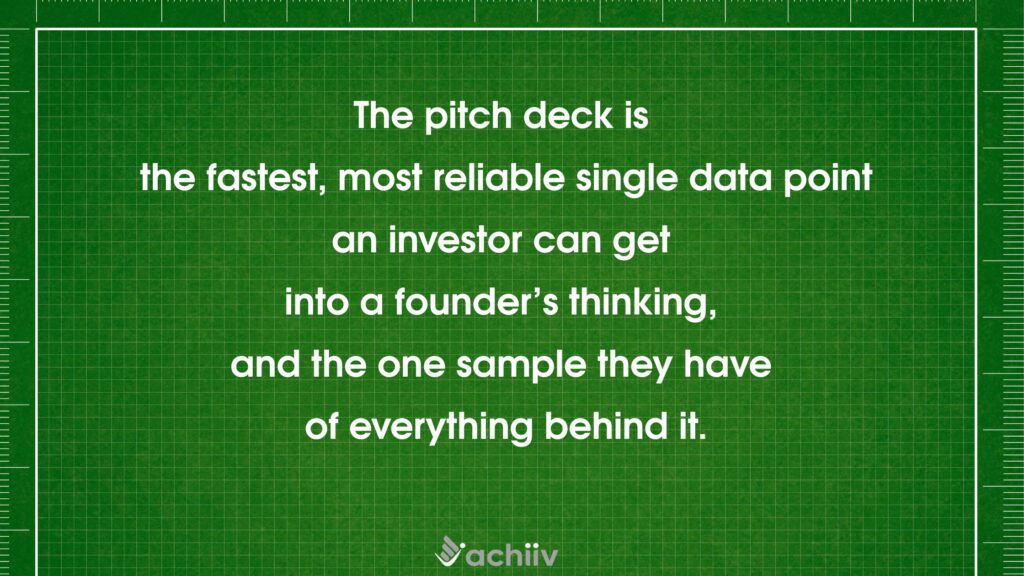What would it feel like to have investors tell you exactly what’s on their minds when they’re looking at your startup? I recently did a deep dive on nearly 75 interviews I’ve done for the Invisible Ink Podcast and discovered that the many investors we’ve spoken to over the years have done exactly that. To save you time, I picked ten of the best and packaged them up for you, along with simple checklists to assess how you stack up.
Ready to roll? Let’s go:
#1: Fundraising is a Marketing Game, So Play It Like One
Your customers will only buy from you if they’re in the market for this product, at this time, and at this price. Investors are customers too, except they’re buying an investment in your company. They’ll only bite if they’re in the market for this specific type of startup (sector, stage, check size), at this time (have funds available to deploy) and at this “price” (deal terms, type of instrument). What they are buying is potential returns from this investment.
Check:
- Are you targeting your “ideal investor persona” (sector, stage and check size), at the right time (have deployable funds), with the right value proposition (deal terms, instrument, expected returns)?
- Are you using a systematic approach to find and “close” on a small subset of the investor prospects you’re talking to?
- Have you checked that they put their money (actual investments) where their mouth (marketing and website language) is?
#2: The Pitch Deck Can’t Seal The Deal, But Can Break It
Too many founders think a great pitch deck is all they need to get funded. Your pitch deck isn’t enough to seal the deal, but it can and often does break it. It’s usually the only data point investors use to decide if you’re worth their time (the default is “no”). It’s the fastest, probably most reliable single data read an investor can get into a founder’s thinking, and the one sample they have of everything behind it.
Check:
- Is your pitch deck the best “sampler” of everything about your opportunity and the progress you’ve made?
- Does it represent the quality and depth of your thinking on the business side, and create confidence in your mastery of the facts and data behind it?
#3: For Deep Tech Founders, It’s All About The Business Side
For many STEM founders, especially in deep tech, it’s all about the technology. But investors are ultimately betting on how much money this technology is going to make from deploying it in the right markets at the right price. They might give you the benefit of the doubt for a while, but if you can’t demonstrate that you understand the money side of things, they’d rather fund a team that can. Financial acumen and leadership in managing the business are paramount, even over proven functionality of your groundbreaking technology.

Check:
- Do you have a deep understanding of the “money side” of the business, especially in deep tech?
- Do you have a strong grasp of a clear business model to deploy this technology?
- Can you talk fluently about the financial upside from this opportunity?
Episodes to watch :
- Commercializing Deep Tech w/ Dr. Tanya Ramond – Invisible Ink Ep. 69
- Made for Medtech: The Essential Fundraising Guide w/ Tasneem Dohadwala Invisible Ink Ep 63
- Fundraising Secrets for STEM Founders w/ Jen Baird – Invisible Ink Ep. 53
- Raise Ready: What Smart Investors Want You to Know w/ Gwen Edwards – Invisible Ink Ep. 52
#4: Investors Look at Pitches Through a Negative Lens, Pitch Accordingly
When fundraising, you focus on the big opportunity in your market. But your investors hear stories like these every single day. The upside is necessary, but not sufficient to win their hearts (and open their checkbooks). They care as much, if not more, about not losing money.
The founder that gets their attention isn’t just opening their eyes to the opportunity – but is also smart about potential risks and how they’ll mitigate them. There’s a catch: if you’re female, you must flip the script and emphasize the upside a lot more than you think, because of investors’ prevention bias when talking to women founders.
Check:
- Have you addressed the biggest risks that can derail your startup? Does your pitch cover risks, their impact and mitigation plans?
- If you’re a woman, are you preparing ahead of time to address and reframe every question on risk to also highlight the upside?
#5: The Financial Model Is Not About The Finances
You may think your financial projections are about demonstrating your startup’s potential. But for early stage investors, the financial model is less about predicting the future perfectly and more about demonstrating how well you understand the core drivers of your business, the quality of your research, and whether you can think critically about the numbers.
Check:
- Do you understand how you came up with the numbers in your projections, even if you didn’t build the model yourself?
- Can you back up your projections with credible data?
- Can you show how your strategy drives the assumptions and results in your projections?
Episodes to watch:
- Building VC-Backable Impact Startups w/ Kerry Rupp – Invisible Ink Ep 56
- Fundraising Secrets for STEM Founders w/ Jen Baird – Invisible Ink Ep. 53
- Startup Funding Isn’t Shark Tank! It’s This. W/ Elaine Bolle – Invisible Ink Ep 55
#6: Dumb Money is Worse Than No Money
Not all money is created equal and not every investor is created equal. Smart money comes with a deep understanding of the startup journey, your needs as a founder at each step, strong networks, and a solid commitment to helping you only where you need it, at the right time and in the right dosage. “Dumb” money not only doesn’t provide all this, but can actively destroy your progress with too much interference.
Check:
- Are you being selective about criteria for investors you’ll take money from?
- Have you done your due diligence on their investing track record, and portfolio companies’ experience with them, especially in hard times?
Episodes to watch:

#7: What You Think is “Feedback” is Usually a Rejection
Investors hate closing doors, so they’ll say anything except “No” when they have no intention of ever moving forward with you. “Oh, it’s a little too early”, or, “Let’s talk again when you have some more traction” are all just investors delivering soft and euphemistic “no’s”. Unless they send you a term sheet, ask for your data room, or provide very specific timelines and clear milestones for you to come back to them, all the things that sound like a “maybe” are just hard “no’s”. On a related note, most investors will never come out and tell you the real reasons they are passing on your idea.
Check:
- Are you being realistic about what investors’ responses to your pitch really mean?
- Do you have qualified experts or advisors who will candidly assess the flaws in your pitch and idea?
#8: Deal Fluency Is a Must-Have
Founders need a foundational understanding of financials and the economics of venture capital. If you’re in a deep dive session with a potential investor and you’re not quite sure what a cap table is, you’re already in trouble. Investors want to deal with financially knowledgeable founders who understand the economics from the investor’s side, know what the funding process entails and are smart about what deal terms mean.
Check:
- Do you have a strong grasp of the economics of investing in your perspective from investors’ point of view?
- Do you understand core concepts like the cap table and what they mean?
- Do you understand the critical elements of a funding deal and term sheet?
Episodes to watch:
- Raise Ready: What Smart Investors Want You to Know w/ Gwen Edwards – Invisible Ink Ep. 52
- Startup Funding Isn’t Shark Tank! It’s This. W/ Elaine Bolle – Invisible Ink Ep 55
- Are SAFEs Really Safe? A Primer on Startup Funding and Valuation w/ Eva Doss – Invisible Ink Ep. 67
#9: Go Prepared With a Deal Structure
Proactively proposing baseline deal terms is often better than just reacting to an investor’s offer. It’s usually better for you to go in and say “Here’s what I am offering” – It shows the investor that you’ve researched the current market, have a starting point for negotiation, and have taken the effort to make the process more efficient and effective from the get-go. It also helps them zero in quickly on whether you’re even in range to start talking specifics.
Check:
- Do you understand what investors need to make from your deal to make it worthwhile?
- Do you have proposed deal terms before going out to raise?
- Have you checked your proposed structure with legal counsel and current funding trends for your sector and stage?

#10: Take The The Long View
Many founders are so focused on the current raise that they’ve never stopped to think about their capital needs in totality. Your total funding need is a very big driver for early stage investors because it tells them how much funding risk your startup carries, and how much their stake is likely to get diluted in those future funding rounds. The sharper and more credible your capital roadmap is, the more confidence you’ll give investors to write that check.
Check:
- Do you have a clear view of how much money you will need in total to take your startup to exit?
- Do you have a credible and realistic understanding of your future raises and the intervals between each raise?
- Do you understand which funders are the best fit at each of these raises?
Episodes to watch:
- To IPO and Beyond: A Techpreneur’s Take. w/ Vinita Gupta – Invisible Ink Ep. 54
- Bootstrapping to a Billion Dollar Exit w/ Lynda Weinman – Invisible Ink Ep 59
Get It Done!
Now you know the game. The next move is yours.
- Do a realistic assessment of where you are. What are the top 3 gaps you need to address?
- What knowledge, skills and resources do you need to fill the gaps?
- What single action will get you furthest in closing the gap?
What step will you take now? Start small. Stay honest. Build forward.
May the force be with you!







